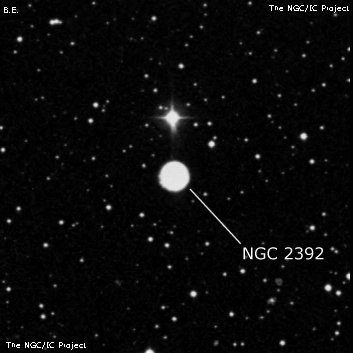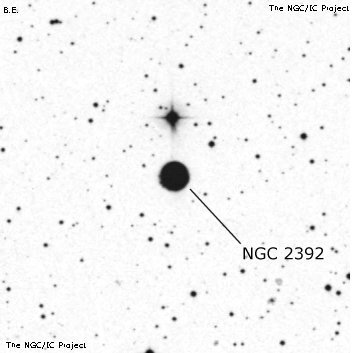NGC/IC Project Restoration Effort
(This is a very very beta version)
NGC2392


Basic Information
Location and Magnitude
Right Ascension: 7:29:10.8
Declination: +20:54:45
Constellation: GEM
Visual Magnitude: 9.1
Historic Information
Discoverer: Herschel W.
Year of discovery: 1787
Discovery aperture: 18.7
Observational
Summary description: B, S, R, * 9 M, * 8 nf 100"
Sub-type: PN
Steve's Notes
=====
NGC 2392
48" (4/1/11): I just took a quick look at the Eskimo at 488x but the view of the double green shells was stunning. The inner, brilliant annulus is irregularly shaped, with an elongated bulge on the north side. The ring essentially splits into two sections at the north end (the inner "ring" is fainter) with a darker interior forming a small pouch within the ring. This feature could be considered the "chin" at the bottom of the Eskimo's "face" in the eyepiece view. The outer shell is irregularly lit and brighter along the southern rim.
18" (2/24/06): viewed at 807x in good seeing. ÊThis remarkable double-shelled planetary has a darker ring around the bright, 9th magnitude central star. The darker ring is surrounded by fairly narrow bright annulus, perhaps 20" in diameter. The rim of the inner annulus appears slightly brighter along the western half and brightest along the northwest section. ÊMoving outwards, a narrow darker ring separates the inner shell from a large, lower surface brightness outer halo that extends to nearly 1' in diameter (listed diameter is only 47").
17.5" (12/19/87): using 410x exhibits a prominent double shell structure with a very bright inner shell about 20" diameter with a darker central hole surrounding a very bright mag 9 central star. The Eskimo has a very high surface brightness with a bluish color and easily takes this magnification. The inner shell is surrounded by a thin dark ring about 2/3 of the way out from center and a faint, barely detached outer halo. Located 1.6' S of mag 8.3 SAO 79428.
13" (1/28/84): bright mag 9 central star surrounded by a double shell with a bright inner disk and a dark ring separates the two shells.



